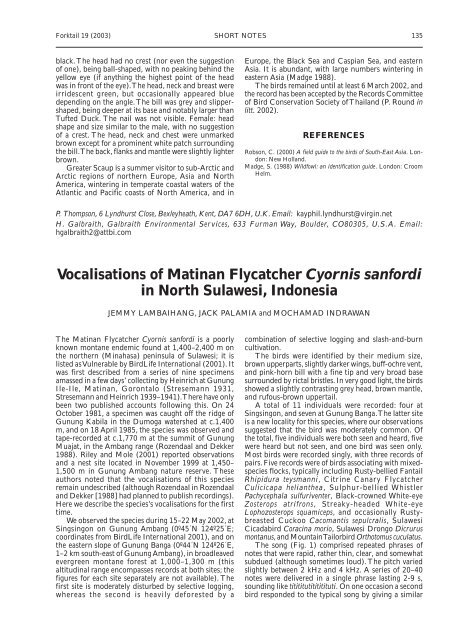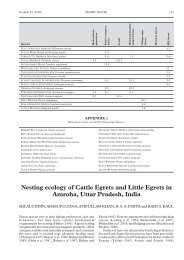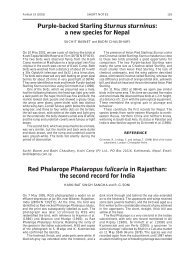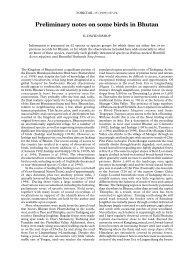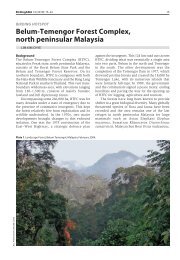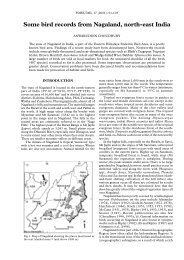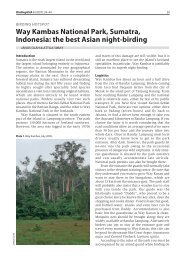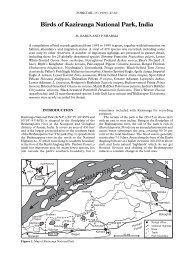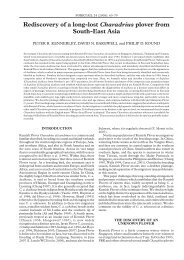Vocalisations of Matinan Flycatcher Cyornis ... - Oriental Bird Club
Vocalisations of Matinan Flycatcher Cyornis ... - Oriental Bird Club
Vocalisations of Matinan Flycatcher Cyornis ... - Oriental Bird Club
You also want an ePaper? Increase the reach of your titles
YUMPU automatically turns print PDFs into web optimized ePapers that Google loves.
Forktail 19 (2003) SHORT NOTES<br />
135<br />
black. The head had no crest (nor even the suggestion<br />
<strong>of</strong> one), being ball-shaped, with no peaking behind the<br />
yellow eye (if anything the highest point <strong>of</strong> the head<br />
was in front <strong>of</strong> the eye). The head, neck and breast were<br />
irridescent green, but occasionally appeared blue<br />
depending on the angle. The bill was grey and slippershaped,<br />
being deeper at its base and notably larger than<br />
Tufted Duck. The nail was not visible. Female: head<br />
shape and size similar to the male, with no suggestion<br />
<strong>of</strong> a crest. The head, neck and chest were unmarked<br />
brown except for a prominent white patch surrounding<br />
the bill. The back, flanks and mantle were slightly lighter<br />
brown.<br />
Greater Scaup is a summer visitor to sub-Arctic and<br />
Arctic regions <strong>of</strong> northern Europe, Asia and North<br />
America, wintering in temperate coastal waters <strong>of</strong> the<br />
Atlantic and Pacific coasts <strong>of</strong> North America, and in<br />
Europe, the Black Sea and Caspian Sea, and eastern<br />
Asia. It is abundant, with large numbers wintering in<br />
eastern Asia (Madge 1988).<br />
The birds remained until at least 6 March 2002, and<br />
the record has been accepted by the Records Committee<br />
<strong>of</strong> <strong>Bird</strong> Conservation Society <strong>of</strong> Thailand (P. Round in<br />
litt. 2002).<br />
REFERENCES<br />
Robson, C. (2000) A field guide to the birds <strong>of</strong> South-East Asia. London:<br />
New Holland.<br />
Madge, S. (1988) Wildfowl: an identification guide. London: Croom<br />
Helm.<br />
P. Thompson, 6 Lyndhurst Close, Bexleyheath, Kent, DA7 6DH, U.K. Email: kayphil.lyndhurst@virgin.net<br />
H. Galbraith, Galbraith Environmental Services, 633 Furman Way, Boulder, CO80305, U.S.A. Email:<br />
hgalbraith2@attbi.com<br />
<strong>Vocalisations</strong> <strong>of</strong> <strong>Matinan</strong> <strong>Flycatcher</strong> <strong>Cyornis</strong> sanfordi<br />
in North Sulawesi, Indonesia<br />
JEMMY LAMBAIHANG, JACK PALAMIA and MOCHAMAD INDRAWAN<br />
The <strong>Matinan</strong> <strong>Flycatcher</strong> <strong>Cyornis</strong> sanfordi is a poorly<br />
known montane endemic found at 1,400–2,400 m on<br />
the northern (Minahasa) peninsula <strong>of</strong> Sulawesi; it is<br />
listed as Vulnerable by <strong>Bird</strong>Life International (2001). It<br />
was first described from a series <strong>of</strong> nine specimens<br />
amassed in a few days’ collecting by Heinrich at Gunung<br />
Ile-Ile, <strong>Matinan</strong>, Gorontalo (Stresemann 1931,<br />
Stresemann and Heinrich 1939–1941). There have only<br />
been two published accounts following this. On 24<br />
October 1981, a specimen was caught <strong>of</strong>f the ridge <strong>of</strong><br />
Gunung Kabila in the Dumoga watershed at c.1,400<br />
m, and on 18 April 1985, the species was observed and<br />
tape-recorded at c.1,770 m at the summit <strong>of</strong> Gunung<br />
Muajat, in the Ambang range (Rozendaal and Dekker<br />
1988). Riley and Mole (2001) reported observations<br />
and a nest site located in November 1999 at 1,450–<br />
1,500 m in Gunung Ambang nature reserve. These<br />
authors noted that the vocalisations <strong>of</strong> this species<br />
remain undescribed (although Rozendaal in Rozendaal<br />
and Dekker [1988] had planned to publish recordings).<br />
Here we describe the species’s vocalisations for the first<br />
time.<br />
We observed the species during 15–22 May 2002, at<br />
Singsingon on Gunung Ambang (0º45´N 124º25´E;<br />
coordinates from <strong>Bird</strong>Life International 2001), and on<br />
the eastern slope <strong>of</strong> Gunung Banga (0º44´N 124º26´E,<br />
1–2 km south-east <strong>of</strong> Gunung Ambang), in broadleaved<br />
evergreen montane forest at 1,000–1,300 m (this<br />
altitudinal range encompasses records at both sites; the<br />
figures for each site separately are not available). The<br />
first site is moderately disturbed by selective logging,<br />
whereas the second is heavily deforested by a<br />
combination <strong>of</strong> selective logging and slash-and-burn<br />
cultivation.<br />
The birds were identified by their medium size,<br />
brown upperparts, slightly darker wings, buff-ochre vent,<br />
and pink-horn bill with a fine tip and very broad base<br />
surrounded by rictal bristles. In very good light, the birds<br />
showed a slightly contrasting grey head, brown mantle,<br />
and rufous-brown uppertail.<br />
A total <strong>of</strong> 11 individuals were recorded: four at<br />
Singsingon, and seven at Gunung Banga. The latter site<br />
is a new locality for this species, where our observations<br />
suggested that the bird was moderately common. Of<br />
the total, five individuals were both seen and heard, five<br />
were heard but not seen, and one bird was seen only.<br />
Most birds were recorded singly, with three records <strong>of</strong><br />
pairs. Five records were <strong>of</strong> birds associating with mixedspecies<br />
flocks, typically including Rusty-bellied Fantail<br />
Rhipidura teysmanni, Citrine Canary <strong>Flycatcher</strong><br />
Culicicapa helianthea, Sulphur-bellied Whistler<br />
Pachycephala sulfuriventer, Black-crowned White-eye<br />
Zosterops atrifrons, Streaky-headed White-eye<br />
Lophozosterops squamiceps, and occasionally Rustybreasted<br />
Cuckoo Cacomantis sepulcralis, Sulawesi<br />
Cicadabird Coracina morio, Sulawesi Drongo Dicrurus<br />
montanus, and Mountain Tailorbird Orthotomus cuculatus.<br />
The song (Fig. 1) comprised repeated phrases <strong>of</strong><br />
notes that were rapid, rather thin, clear, and somewhat<br />
subdued (although sometimes loud). The pitch varied<br />
slightly between 2 kHz and 4 kHz. A series <strong>of</strong> 20–40<br />
notes were delivered in a single phrase lasting 2-9 s,<br />
sounding like titititutitititituti. On one occasion a second<br />
bird responded to the typical song by giving a similar
136 SHORT NOTES<br />
Frequency (kHz)<br />
10<br />
8<br />
6<br />
4<br />
2<br />
0<br />
0 1 2 3<br />
Time (seconds)<br />
4 5<br />
Figure 1. Song <strong>of</strong> <strong>Matinan</strong> <strong>Flycatcher</strong> <strong>Cyornis</strong> sanfordii in North Sulawesi, Indonesia<br />
song, delivered at a slower rate and with greater emphasis<br />
on each note (ti-ti-ti-tu-ti-ti-ti-ti-tu-ti). Individuals were<br />
observed singing for up to 30 mins, with birds rarely<br />
changing perch during singing bouts. The warbling song<br />
is not dissimilar to that <strong>of</strong> Pale Blue <strong>Flycatcher</strong> <strong>Cyornis</strong><br />
unicolor, except that the latter has markedly shorter<br />
phrases (B. van Balen pers comm. 2002, commenting<br />
on recording).<br />
ACKNOWLEDGEMENTS<br />
We thank: Myron Shenkelle for providing assistance with preparing<br />
the sonogram; Bas van Balen for help in describing the song; and Jon<br />
Riley for kindly commenting on a draft <strong>of</strong> this note.<br />
REFERENCES<br />
Forktail 19 (2003)<br />
<strong>Bird</strong>Life International (2001) Threatened birds <strong>of</strong> Asia: the <strong>Bird</strong>Life<br />
International red data book. Cambridge, U.K.: <strong>Bird</strong>Life International<br />
Riley, J and Mole, J. (2001) The birds <strong>of</strong> Gunung Ambang Nature<br />
Reserve, North Sulawesi, Indonesia. Forktail 17: 57–66.<br />
Rozendaal, F. G. and Dekker, R. W. R. J. (1989) An annotated checklist<br />
<strong>of</strong> the birds <strong>of</strong> the Dumoga–Bone National Park, North<br />
Sulawesi. Kukila 4: 85–108.<br />
Stresemann, E. (1931) Vorläufiges über die ornithologischen<br />
Ergebnisse der Expedition Heinrich 1930–1932. Orn. Monatsber.<br />
39: 7–14, 44–47, 77–85, 102–105, 167–171.<br />
Stresemann, E. and Heinrich, G. (1939–1941) Die Vögel von Celebes.<br />
J. Orn. 87: 299–425; 88: 1–135, 389–487; 89: 1–102.<br />
Jemmy Lambaihang and Jack Palamia, KOFFAS (Konservasi Flora dan Fauna Sulawesi), Kotak Pos 35, Bitung<br />
95501, Sulawesi, Indonesia.<br />
Mochamad Indrawan (corresponding author), Department <strong>of</strong> Biology, Universitas Indonesia, Depok 16421, Jawa Barat,<br />
Indonesia. Email: jamblang@cbn.net.id<br />
First records <strong>of</strong> Spoon-billed Sandpiper<br />
Calidris pygmeus in the Indian<br />
Sundarbans delta, West Bengal<br />
On 22 November 2001, I visited the Sagar Island in the<br />
western part <strong>of</strong> the Sundarbans Biosphere Reserve, West<br />
Bengal. At 06h15 I found a small stint foraging on the<br />
mudflats. I observed this bird for more than 20 minutes<br />
with 10x50 binoculars at a distance <strong>of</strong> c.25 m. At 06h55<br />
another solitary individual was sighted c.500 m from<br />
the first individual, and this bird was watched for 15<br />
minutes at a distance <strong>of</strong> 20 m.<br />
Both individuals were easily identified as Spoonbilled<br />
Sandpipers Calidris pygmeus by their flattened<br />
spatulate bills and their extraordinary foraging<br />
behaviour, in which they ran quickly across the mudflat,<br />
stopping regularly to feed by sweeping the submerged<br />
bill-tip from side to side. Both were adults in winter<br />
plumage, and no plumage differences were noted<br />
ARUNAYAN SHARMA<br />
between them. They had unstreaked white underparts,<br />
and greyish-brown upperparts, with dark shaft-streaks<br />
on the wing-coverts, back and mantle. The forehead and<br />
prominent supercilium were white, the crown was<br />
streaked darker, and the ear-coverts were largely pale.<br />
The rump and uppertail-coverts were dark grey-brown,<br />
with white at the sides. The tail was dark brown with<br />
whitish fringes to the outer rectrices. A white wing-bar<br />
was prominent in flight. The second individual called<br />
twice, giving a shrill, ascending ‘whoeatt…whoeatt’.<br />
One <strong>of</strong> these individuals, or another, was watched<br />
for 30 minutes at a distance <strong>of</strong> 25 m at the same spot at<br />
06h30 on 23 November. During 7–14 December 2001,<br />
I observed Spoon-billed Sandpipers on eight occasions<br />
at various locations in the Sundarbans tiger reserve


